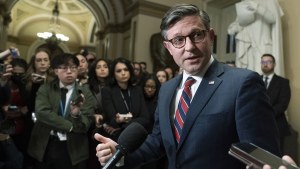Majorities across the American melting pot support continued US aid to Kyiv.
In April, President Joe Biden signed into law a national security supplemental aid package that allocates more than $95 billion in security assistance to Ukraine, Israel, and Taiwan. The individual bills that made up the package faced months of delay and significant opposition from different segments in both the Senate and the House. Hardline Republicans resisted efforts to continue sending aid to Ukraine, while progressive Democrats insisted on making further aid to Israel conditional. Ukraine is now set to receive $61 billion in military, economic, and humanitarian aid over the next several months that will bolster its military infrastructure and defense efforts.
The September 2023 Chicago Council Survey and a series of focus groups conducted in March 2024 in conjunction with New America find that contention over US support for Ukraine extends far beyond Washington and exists between everyday Americans from different racial, ethnic, and generational backgrounds.
Key Findings
- Majorities across racial, ethnic, and generational groups supported sending economic and military aid to Ukraine but to a lesser degree among Black, Hispanic, Millennial, and Generation Z Americans.
- Black, Hispanic, Generation X, and Millennial Americans were also less willing to endure higher costs of living to support Ukraine for as long as it takes to retake its territory from Russia and instead preferred that the United States encourage Kyiv to settle for peace.
- Asian, Hawaiian, or Pacific Islander (AAPI), White, Silent Generation, and Baby Boomer Americans were more convinced that investments the United States has made in weapons transfers to Ukraine have been worth the cost.
- Partisanship seems to play a much stronger and more divisive role in shaping attitudes toward the Russia-Ukraine war, since differences between racial, ethnic, and generational groups occur in degree rather than direction.
Greater Support for Assistance to Ukraine among White, Asian, and Older Americans
In the 2023 Chicago Council Survey, fielded September 7–18, 2023, six in 10 Americans said they support sending additional economic (61%) and military aid (62%) to Ukraine. While still considerable, support for assisting Ukraine’s war efforts declined since the start of the Russian military operation, at which point nearly eight in 10 Americans favored sending aid to Kyiv (78% economic and 79% military).
Partisanship has played a key role in the declining rates of support for sending additional aid to Ukraine among Americans. In September, only about half of Republicans supported continuing US assistance to Ukraine (47% economic and 50% military) compared to more than three-quarters of Democrats (76% economic and 77% military), A more recent survey shows that these partisan divisions continue to widen, as even fewer Republicans now say they support sending economic and military aid to Ukraine (40% economic and 45% military) while Democratic support remains steadfast (78% economic and 75% military).
Demographic characteristics such as race, ethnicity, and age have a much weaker effect on public preferences for Ukraine comparatively. For the most part, majorities across the American melting pot supported sending economic and military aid to help bolster Kyiv’s war efforts. AAPI Americans were the most likely to support continued aid to Ukraine and were followed by White Americans. Roughly six in 10 Black Americans and Hispanic Americans favored continued aid, while Native or Alaskan Americans were more divided.
Focus groups conducted March 13–19, 2024, among Black, AAPI, and Hispanic Americans shed some light on Americans’ continued support for sending aid to Ukraine. Many Black American participants pointed to a number of things they think the Biden administration has done well over the course of the war in Ukraine, including its "vocal articulation of support for Ukrainian sovereignty and sanctions against Russia;” “providing resources—whether its money, equipment or training;” and providing humanitarian assistance.
One Hispanic American participant praised the Biden administration for building an international coalition to support Ukraine and avoiding direct US intervention: “We’re doing a good job supporting Ukraine without getting boots on the ground. We’ve helped build and maintain a coalition of nations to contain Russian expansionism.”
However, not all participants were positive in their assessments of the Biden administration’s handling of the war in Ukraine. One Hispanic American participant complained that the United States is “not continuing to provide [Ukraine] the support when needed. Not providing planes. Not providing enough support so they can actually get Russia out of their country.” An Asian American participant noted that the United States doesn’t “have a plan for the future; continuing to send money for this never-ending war.” A few Black American participants criticized the government for “investing too much financially,” pointing to the United States “giving and giving for the past two years while people in other countries need assistance as well, like Sudan.”
“We should be writing mostly blank checks to keep the devil at bay, honestly, and consider that every Ukrainian who dies is an American that doesn’t have to.”
There were also differences in the degree of support for sending additional aid to Ukraine between younger and older generations of Americans. Majorities of older Americans, and particularly those from the Silent and Baby Boomer generations, favored sending economic assistance and military supplies to Ukraine. By contrast, Millennials and Generation Z were less likely to support sending economic aid and military assistance to Kyiv.
Focus group discussions among 18-to-29-year-old Americans also highlighted some selective praise for current US policy toward Ukraine. One participant said, “Our military aid has been astounding; it is almost unbelievable the amount that Ukraine has been able to resist Russia’s invasion of this small nation with much fewer resources.” Another stated, “We should be writing mostly blank checks to keep the devil at bay, honestly, and consider that every Ukrainian who dies is an American that doesn’t have to.”
On the other hand, some young Americans cautioned about the US government having realistic goals. “I think it should address where we stand and understand that we can have limitations in helping unless there is more we can do.” Another added, “we may have become too involved, as we’ve sent about $75 billion to Ukraine, neglecting our own issues while increasing our national debt.”
The February 2024 Chicago Council-Ipsos survey also found declining support for sending aid to Ukraine among Black and Hispanic Americans, as well as among Millennials and Generation Z. Like Democrats, White and older Americans held steadfast in their support (see Appendix Tables 1-4).
Divided Views on Whether US Aid to Ukraine Should Continue “As Long as It Takes”
While the majority of Americans support sending additional aid to Ukraine, there is less consensus on how long the United States should continue its assistance, especially if it means costs for consumers will be impacted. In September 2023, about half the public thought the United States should support Ukraine for as long as it takes even if it means higher prices for US households (47%). The other half preferred that the United States encourage Ukraine to negotiate so that costs for US households would not increase, even if it meant Ukraine would have to forfeit some of its territory (49%). Among Republicans, the majority preferred that the United States encourage negotiation (66%), while the majority of Democrats favored supporting Ukraine for as long as it takes (62%).
“I think there is a LIMIT to what we should give monetarily. . . . This is money that can desperately be used to strengthen struggling communities within [the] US.”
Americans of different races and ethnicities are similarly fragmented on whether to support Ukraine indefinitely. Native or Alaskan, White, and AAPI Americans are closely divided on this item but lean toward assisting Ukraine for as long as it takes. On the other hand, Black and Hispanic Americans are less willing to endure higher gas and food prices to support Ukraine’s territorial integrity and would rather the United States encourage Kyiv to negotiate for peace. The data suggest that household incomes, which are distributed differently across racial and ethnic groups, may play a role in these views. White and AAPI Americans have higher household incomes than Black and Hispanic Americans and thus could be more willing to endure higher costs of living to support Ukraine indefinitely (see Appendix Table 5).
Focus group participants also debated between supporting Ukraine indefinitely and negotiating an end to the war. One Hispanic American thought “Biden could do more to negotiate a settlement between the two countries,” while an Asian American agreed that the administration is “not trying to foster peace and reconciliation between the two countries, but instead supplying more military resources that prolong the war.”
Several participants also commented on the tradeoff between financing a foreign conflict and instead using that money to solve domestic challenges. One Asian American participant said there is “too much spending with no end in sight.” A participant in the Black American focus group echoed this sentiment, saying, “I think there is a LIMIT to what we should give monetarily. At some point, these monies given; how will they be repaid along with military equipment? This is money that can desperately be used to strengthen struggling communities within [the] US.”
In a similar vein, Americans of different generations were somewhat divided on whether the United States should support Ukraine’s war efforts for as long as it takes. A slight majority of the Silent Generation, Boomers, and, notably, Generation Z, said they would support Ukraine for the long run. On the other hand, Generation X and Millennials were less willing to endure higher costs of living to defend Ukraine.
Although a slim majority of Generation Z said they are willing to support Ukraine’s defense efforts for as long as it takes, many focus group participants highlighted the necessity of negotiating a resolution to the conflict. One participant said, “The United States should be pushing for a ceasefire and end to the war. Putin has indicated that he is ready to negotiate a peace, therefore we need to begin negotiating and settling the senseless conflict.”
Another young focus group participant who supported US assistance to Ukraine said: “It has been unwise, however, to support Ukraine ‘no matter what.’ There needs to be an off ramp, and it is unlikely that Ukraine will be marching into Moscow. . . . Zelensky is in no political position to surrender, so Biden has to be the ‘bad guy’ and initiate negotiations.”
Additional Divisions on Whether US Aid to Ukraine Has Been Worth Costs
There are similar divisions on whether the assistance the United States has given to Kyiv have been worthwhile. In the 2023 Chicago Council Survey, a narrow majority of Americans said the $43 billion in weapons, equipment, and training that the United States has provided to Ukraine has been worth the cost (53% vs. 45% not worth the cost). The majority of Republicans said it has not been worth the cost (61%), while the majority of Democrats said it has been (69%).
The data show that AAPI and White Americans are most inclined to say the investments the United States has made in weapons transfers and training for Ukraine has been worth the cost (57% and 54%, respectively). Comparatively, Black and Hispanic Americans express less confidence that US military aid to Ukraine has been worth the cost and are divided equally (both say worth the cost at 49%). Native/Alaskan Americans are the least likely to say it has been worth the cost (43%), as a slim majority said it has not been worth the cost (52%).
In focus groups, participants weighed the factors at stake in Russia’s conflict with Ukraine, helping to explain why some Americans think US military aid to Ukraine has been worth the cost. Black American participants stated, “If Russia is not defeated in Ukraine, Putin and his cohorts will feel empowered to keep expanding their invasions of terror and domination,” and “Russia could continue to invade other countries including NATO countries,” which could prompt “allied countries to become involved in armed conflict.” However, another Black participant characterized the war in Ukraine as “nothing but a central bank war like the last two world wars.”
Hispanic and Asian American participants also cited a risk of Russian aggression: “Putin is on a suicide mission. Russia will become even more dangerous if they win and remain unchecked;” “democracy and peace in other Eastern European countries and possibly Western Europe [is at stake].” Several other participants of different racial and ethnic backgrounds warned against the possibility of higher gas and food prices, a humanitarian crisis, nuclear war, World War III, and challenges to the global order and world peace.
The Silent Generation and Baby Boomers are much more convinced that the amount of military aid sent to Ukraine has been worth the cost than their younger counterparts. By contrast, younger Americans resemble the overall public: roughly divided on whether the high cost of supporting Ukraine’s war effort has been worth it or not. Millennials are the least convinced of the value of US military aid to Ukraine.
Focus groups among young adults revealed that they see many of the same issues at stake [as older participants] when it comes to the outcome of the war with Ukraine. “If Russia takes over Ukraine it will NOT stop there. It will keep taking over other countries to increase its global power.” Another participant noted their worries about a “recurrence of Cold War era fracturing of Europe,” while others chimed in about the possibility of another world war and “runaway military buildup.” However, one young adult questioned the importance of Ukraine, saying, “It’s a tiny country that holds no real significance.”
Conclusion
Disputes over the United States’ continued assistance to Ukraine have only intensified in the third year of the war between Russia and Ukraine. Just as US leaders consider other international commitments and geopolitical risks, Americans across different racial, ethnic, and generational groups are also weighing the global balance of power against what many perceive as more-pressing domestic concerns.
Americans of different demographic backgrounds vary in the degree of support for sending additional aid to Ukraine. However, they favor the same general direction for US policy, namely, to continue US aid to Ukraine. Overall, Black, Hispanic, Millennial, and Generation Z Americans are less likely than others to support funding Ukraine’s defense efforts or see the value in doing so. However, the data also show that partisanship plays a stronger and more divisive role in shaping Americans’ attitudes toward the war than these demographic characteristics.
Table 1. Support for Sending Aid to Ukraine (February 2024)
In response to the situation involving Russia and Ukraine, would you support or oppose the United States . . .? (% support)
| White, non-Hispanic | Black, non-Hispanic | HISpanic | Other | |
|---|---|---|---|---|
| Providing economic assistance to Ukraine | 58 | 50 | 54 | 77 |
| Sending additional arms and military supplies to the Ukrainian government | 61 | 49 | 51 | 67 |
| Sending US troops to Ukraine to help the Ukrainian government defend itself against Russia | 28 | 21 | 28 | 34 |
Table 2. Support for Sending Aid to Ukraine (September 2023)
In response to the situation involving Russia and Ukraine, would you support or oppose the United States . . .? (% support)
| White, non-Hispanic | Black, non-Hispanic | HISpanic | Other | |
|---|---|---|---|---|
| Providing economic assistance to Ukraine | 61 | 57 | 59 | 72 |
| Sending additional arms and military supplies to the Ukrainian government | 64 | 60 | 60 | 65 |
| Sending US troops to Ukraine to help the Ukrainian government defend itself against Russia | 22 | 31 | 34 | 32 |
Table 3. Support for Sending Aid to Ukraine (February 2024)
In response to the situation involving Russia and Ukraine, would you support or oppose the United States . . .? (% support)
| Silent | Baby Boomer | Generation X | Millennial | Generation Z | |
|---|---|---|---|---|---|
| Providing economic assistance to Ukraine | 80 | 65 | 60 | 50 | 51 |
| Sending additional arms and military supplies to the Ukrainian government | 80 | 67 | 62 | 51 | 46 |
| Sending US troops to Ukraine to help the Ukrainian government defend itself against Russia | 26 | 21 | 30 | 30 | 30 |
Table 4. Support for Sending Aid to Ukraine (September 2023)
In response to the situation involving Russia and Ukraine, would you support or oppose the United States . . .? (% support)
| Silent | Baby Boomer | Generation X | Millennial | Generation z | |
|---|---|---|---|---|---|
| Providing economic assistance to Ukraine | 77 | 68 | 59 | 56 | 53 |
| Sending additional arms and military supplies to the Ukrainian government | 74 | 69 | 58 | 58 | 64 |
| Sending US troops to Ukraine to help the Ukrainian government defend itself against Russia | 12 | 18 | 28 | 32 | 36 |
Table 5. Distribution of Income across Racial and Ethnic Groups
| Household INcome | White, non-Hispanic | Black, non-Hispanic | Asian or Hawaiian, Pacific Islander | American Indian or Alaska Native | Hispanic |
|---|---|---|---|---|---|
| Under $10,000 | 3 | 6 | 2 | 6 | 3 |
| $10,000-$24,999 | 7 | 11 | 7 | 8 | 9 |
| $25,000-$49,999 | 14 | 20 | 9 | 16 | 19 |
| $50,000-$74,999 | 14 | 18 | 10 | 19 | 19 |
| $75,000-$99,999 | 13 | 14 | 10 | 17 | 14 |
| $100,000-$149,999 | 20 | 15 | 20 | 23 | 17 |
| $150,000 or more | 29 | 17 | 41 | 12 | 18 |
This report is based on data from the 2023 Chicago Council Survey, a series of four focus group sessions, and two omnibus surveys.
The 2023 Chicago Council Survey is an annual study of American public opinion toward US foreign policy conducted and analyzed by the Lester Crown Center’s survey team. Fielded September 7-18, 2023, by Ipsos using its large-scale, nationwide, online research panel, KnowledgePanel, the survey was conducted in both English and Spanish among a national weighted sample of 3,242 adults 18 or older living in all 50 US states and the District of Columbia.
The 2023 survey sample is composed of a main sample (n=2,184) and several supplementary “booster” oversamples that allow for more detailed demographic analysis: a Hispanic oversample (n=305), a Black American oversample (n=281), an American Indian/Alaskan Native oversample (n=123), a Native Hawaiian/Pacific Islander oversample (n=129), and an Asian oversample (n=330). The subsample of Native Americans and Alaskan Natives is small and required significant weighting to match the population demographics noted in the March 2023 Current Population Survey Supplemental Data. As such, conclusions drawn from this sample should be considered suggestive and interpreted with caution. The margin of sampling error for the full sample is ±2.0 percentage points including a design effect of 1.2908. The margin of error is higher for partisan, racial and age subgroups or for partial-sample items.
Partisan identification is based on respondents’ answer to a standard partisan self-identification question: “Generally speaking, do you usually think of yourself as a Republican, a Democrat, an independent, or what?”
Americans are categorized into generational cohorts based on their birth year. Those born between 1928 and 1945 are considered the Silent Generation; between 1946 and 1964 are considered the Baby Boom Generation; between 1965 and 1980 are considered Generation X; between 1981 and 1996 are considered the Millennial Generation; and finally, between 1997 and 2013 are considered Generation Z.
The 2023 Chicago Council Survey was made possible by the generous support of the Crown family, the Korea Foundation, the United States-Japan Foundation, and New America.
The Chicago Council and Ipsos also conducted a survey from February 16-18, 2024, using Ipsos’ large-scale, nationwide, online research panel, KnowledgePanel, among a weighted national sample of 1,039 adults 18 or older living in all 50 US states and the District of Columbia. The margin of sampling error for the full sample is ±3.2 percentage points including a design effect of 1.09. The margin of error is higher for partisan, racial and age subgroups.
The Chicago Council and Ipsos conducted an additional survey from March 8–10, 2024, using Ipsos’ large-scale, nationwide, online research panel, KnowledgePanel, among a weighted national sample of 1,024 adults 18 or older living in all 50 US states and the District of Columbia. The margin of sampling error for the full sample is ±3.1 percentage points including a design effect of 1.09. The margin of error is higher for partisan, racial and age subgroups.
Finally, Ipsos conducted four online focus groups among Hispanic Americans; Black Americans; Asian, Hawaiian, or Pacific Islander Americans (AAPI); and young Americans between the ages of 18-29, between March 13 and 19, 2024. Each of the respondents were members of the KnowledgePanel, Ipsos’ probability-based, online panel, and had previously completed the Chicago Council’s Annual Survey in September 2023. Respondents were recontacted in March 2024 to participate in an 80-minute, online focus group. Each group was conducted among 24 to 49 participants of like age, racial and ethnic backgrounds. Ipsos’ online focus group methodology, called “Ipsos Ideation Exchange,” is built on the Converge platform. Respondents are led through a series of exercises, proctored by a human moderator. Respondents answer questions individually first, with respondents being able to see other participants responses and build on them. Respondents participate using a mix of open-end response, voting, rating and ranking exercises.










Related Content
 Public Opinion
Public Opinion
However, Republican support for providing US assistance continues to steadily decline.
 US Foreign Policy
US Foreign Policy
But everyday Republicans are divided over the best way to encourage NATO allies to increase their defense spending.
 Public Opinion
Public Opinion
Most Americans see military power and security alliances as an effective way to achieve foreign policy goals, but differences emerge about when to deploy troops.


